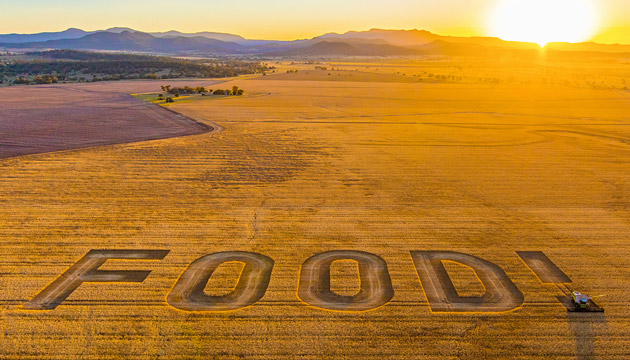Rather than trying to feed the world, Australian producers are now focused on creating food that’s tastier, healthier and more valuable.
Story Ken Eastwood Photo Josh Smith
Like a bridegroom at a wedding, Simon Vause arrives with a beaming smile, on ground carpeted with white confetti petals, riding a four-wheeler. Festooned in white, his celebratory crowd is made up of five-metre high almond trees – nonpareil, carmel and peerless varieties – lined up beside Pike Creek in the Riverland of South Australia, part of the vast Murray Darling Basin, where one-third of Australia’s food is produced.
Each one of these 3750 trees will bring him gifts in a few months’ time – about 14 kilograms of almond kernels. The nuts will be hulled, sorted, pasteurised and packaged in Almondco plants around Renmark. Half of them will end up in Aussie tummies, and the rest probably in Japan, or 40 other export destinations.
Despite the beautiful scene, Simon is pragmatic about the trees. Pointing at one, his hand half-frozen from adjusting sprinklers in the 4-degree Celsius morning, he says, “That’s a factory there – the more inputs you put in, the more output you get.” Simon ensures each tree produces well above average yields. He gives them about 14 megalitres of water per hectare each year, and keeps them well fertilised with a fish emulsion and kelp blend, urea and magnesium. “Almonds just love our conditions here,” he says. “They love our cold winters and they don’t seem to give a rat’s about a 40°C summer day.”
Simon and his little factories are part of Australia’s most profitable horticultural industry – almond exports are now worth almost half a billion dollars a year and the industry is growing exponentially. In 2000, Australia had 3500ha of planted almonds. They now occupy 10 times that amount of land and collectively produce 81,000 tonnes.
Simon had no farming background but is one of a new breed of growers determined to produce food smarter. He was previously a sales representative for Telecom (later Telstra) in Adelaide, and when he married Melissa, whose family ran a fleet of houseboats on the Murray, they decided they wanted to bring up children in the bush. They bought the orchard 22 years ago – initially as a way to minimise tax – and replaced some of the existing citrus and stone fruit trees with almonds. Simon found out how profitable almonds could be – and that they were much less work than stone fruit – and gradually changed the orchard and his own work to focus fully on the nuts. “I didn’t grow up as a farmer so I wouldn’t say it’s in my blood,” he says. “I had to learn the whole thing from scratch, but I’ve always been very business minded – how much do we put in and how much do we get out?”
With a relatively small orchard compared to some corporates, Simon focuses on incremental tweaks and micro changes that will procure him even a 1 percent greater return. “This product fills a gap and gives people choice and variety, particularly with growing gluten and dairy intolerances,” he says.
Although Australia is now the second-biggest almond producer in the world – growing about 8% of world supply – our output is completely overshadowed by California in the USA, which produces about 80%. And this is the story of much Australian produce. As a general rule, Australia grows high quality, safe food in large enough quantities to feed Australia and with plenty to spare. We export more than half of our agricultural produce. But it only accounts for about 2% of global food trade and our relatively high production costs mean that is unlikely to change. Experts no longer talk about us “feeding the world” or being the “food bowl of Asia” as they did a decade or so ago. Instead, we are being positioned as the exporters of higher quality, niche and premium produce.
“We make enough food to feed 60 million people,” says Professor Martin Cole, deputy director of CSIRO Agriculture and Food. “Even if we tripled that or quadrupled that, it would be a drop in the ocean. It would still be less than 1% of the world’s food needs. We’re not going to be the food bowl of Asia, so let’s be the delicatessen and celebrate how we’re different.”
Martin says that the world’s massively growing middle class, expected to reach 3.5 billion people soon, is driving trends towards healthier, niche and convenience foods, putting Australia in a great position. “Australian food and agriculture exports have grown by $7.4 billion over the past three years and, for the first time, over half of this growth [60%] has come from premium or value-added products – the standouts being nutritionals [such as dietary supplements], infant formula and chilled beef. They’re not just niche products – it could be organic produce, or it could be moving up the scale from live-export beef to frozen beef to boxed, chilled beef,” he says. “We’ve done amazing things in growing crops in what is a challenging environment, but rather than all the emphasis on yield, we’re now going to look at more quality traits.”
This new, increasingly positive way of looking at Australia’s food production is buoyed by two burgeoning markets – China (now our number one export market for food) and Japan. “Seven years ago, it was looking pretty tough for the food business in Australia,” Martin says. “The dollar was high, and we were still really in the mining boom, so food wasn’t a high priority. In terms of food manufacturing, we were losing the balance of trade – importing more than we were exporting. But in the last 2–3 years, the dollar rate has fallen and we’ve changed from the mining boom to a dining boom.”
This story excerpt is from Issue #116
Outback Magazine: December/January 2018










